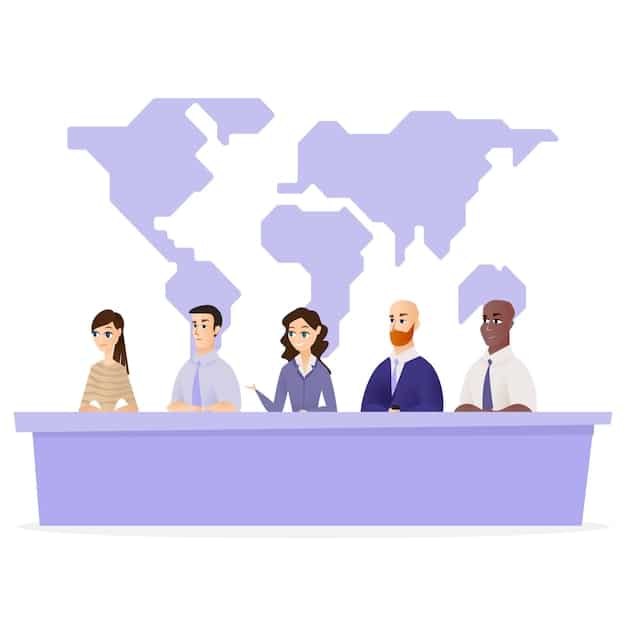WTO Changes: Impact on US Trade Practices

Proposed changes to the World Trade Organization (WTO) could significantly reshape US trade practices by altering dispute resolution mechanisms, subsidy regulations, and market access agreements, potentially impacting various sectors of the US economy.
The World Trade Organization (WTO) stands as a cornerstone of global commerce, but it’s facing potential reforms that could dramatically alter the landscape of international trade. Understanding how will the proposed changes to the World Trade Organization affect US trade practices? is crucial for businesses, policymakers, and anyone with a stake in the American economy.
Understanding the World Trade Organization
The World Trade Organization (WTO) is an intergovernmental organization that regulates international trade. Established in 1995, it evolved from the General Agreement on Tariffs and Trade (GATT), which was created in 1948. The WTO’s primary purpose is to ensure that trade flows as smoothly, predictably, and freely as possible.
The WTO operates on several core principles, including non-discrimination (the most-favored-nation principle and national treatment), freer trade through negotiation, predictability through binding and transparent rules, fair competition, and special provisions for developing countries. These principles are designed to create a level playing field for international trade, fostering economic growth and development.
Key Functions of the WTO
The WTO performs several critical functions that are essential to the global trading system. These functions include:
- Negotiating trade agreements: The WTO provides a forum for member countries to negotiate and reduce barriers to trade, such as tariffs and quotas.
- Administering trade agreements: The WTO ensures that member countries adhere to the trade agreements they have signed, monitoring their trade policies and practices.
- Dispute settlement: The WTO provides a mechanism for resolving trade disputes between member countries, helping to prevent trade wars and maintain stability in the global trading system.
- Providing technical assistance: The WTO offers technical assistance and training to developing countries to help them participate more effectively in international trade.

The WTO’s dispute settlement mechanism is particularly important. When a member country believes that another member has violated a trade agreement, it can bring a case to the WTO. The WTO’s Dispute Settlement Body (DSB) then investigates the case and issues a ruling. If the ruling finds that a violation has occurred, the violating country must take steps to comply with the ruling, or face potential trade sanctions.
In conclusion, the World Trade Organization plays a crucial role in facilitating international trade and resolving trade disputes, contributing significantly to the stability and growth of the global economy.
Overview of Proposed Changes to the WTO
The World Trade Organization (WTO) is currently facing significant pressure to reform its operations due to various criticisms and evolving global trade dynamics. These proposed changes aim to address long-standing issues related to the dispute settlement mechanism, transparency, and the treatment of developing countries.
Several factors have contributed to the push for WTO reform. The US, in particular, has raised concerns about the WTO’s dispute settlement system, arguing that it has overstepped its mandate and infringed on national sovereignty. Other countries have criticized the WTO for its lack of transparency and its failure to adequately address the challenges posed by state-owned enterprises and digital trade.
Key Areas of Proposed Reform
The proposed reforms to the WTO cover several key areas, including:
- Dispute Settlement Mechanism: Reforming the dispute settlement system to ensure its impartiality, efficiency, and effectiveness. This includes addressing concerns about the appointment of appellate body members and the scope of WTO rulings.
- Transparency and Notification: Enhancing transparency by improving the notification requirements for member countries’ trade policies and practices. This would help to ensure that all countries have access to timely and accurate information about trade-related measures.
- Special and Differential Treatment: Re-evaluating the special and differential treatment provisions for developing countries, which allow them to have more flexibility in implementing WTO rules. Some countries argue that these provisions are outdated and no longer reflect the diverse economic conditions of developing countries.
The proposed changes to the WTO are significant and could have far-reaching implications for the global trading system. As negotiations continue, it will be important for all member countries to work together to find solutions that address the challenges facing the WTO and ensure that it remains a relevant and effective organization in the 21st century.
In conclusion, the proposed changes to the WTO reflect a growing recognition of the need to adapt the organization to the realities of the modern global economy and address the concerns of its member countries.

Potential Impacts on US Trade Policy
The proposed changes to the WTO could have significant implications for US trade policy. Depending on the nature and extent of these reforms, the US may need to adjust its trade strategies and practices to remain competitive in the global market.
One potential impact is on the US’s ability to use trade remedies, such as anti-dumping and countervailing duties, to protect its domestic industries from unfair competition. If the WTO’s rules on trade remedies are tightened, the US may find it more difficult to impose these measures, potentially leading to increased imports and job losses in certain sectors.
Effects on Trade Agreements
The proposed changes could also affect the US’s approach to negotiating trade agreements. If the WTO’s dispute settlement system is weakened, the US may be more inclined to pursue bilateral or regional trade deals, rather than relying on the WTO to enforce its rights. This could lead to a more fragmented global trading system, with different sets of rules and standards for different regions.
- Increased Scrutiny on Subsidies: The US may face increased scrutiny of its subsidy programs, particularly those that support agriculture and manufacturing.
- Altered Dispute Resolutions: The US may need to adapt its dispute resolution strategies if the WTO’s dispute settlement mechanism is reformed.
- New Trade Opportunities & Compliance: The US could gain new trade opportunities by complying with updated WTO rules, especially in digital trade and environmental goods.
The proposed changes to the WTO could also create new opportunities for the US. For example, if the WTO is able to address the challenges posed by state-owned enterprises and digital trade, the US may be able to gain greater access to these markets, boosting its exports and creating new jobs.
In conclusion, the potential impacts of the proposed changes to the WTO on US trade policy are complex and multifaceted. The US will need to carefully assess these impacts and develop strategies to mitigate any potential risks and capitalize on any new opportunities.
US Concerns Regarding the WTO and Proposed Solutions
The United States has long voiced concerns regarding the World Trade Organization, primarily centered on issues of sovereignty, fairness, and the effectiveness of the dispute resolution mechanism. These concerns have driven the US to propose and support certain solutions to enhance the WTO’s functionality and legitimacy.
One of the foremost concerns is the perceived overreach of the WTO’s appellate body in interpreting trade agreements. The US has argued that the appellate body has, at times, created new obligations for member states that were not initially agreed upon, thereby infringing on national sovereignty. This has led the US to block the appointment of new appellate body members, effectively paralyzing the dispute resolution system.
Proposed Solutions and Adjustments
To address these concerns, the US has proposed several solutions:
- Reforms to the Dispute Settlement Mechanism: Insisting on reforms that ensure the appellate body adheres strictly to the text of trade agreements and does not create new obligations.
- Enhancing Transparency: Pushing for greater transparency in the WTO’s decision-making processes and in member states’ trade policies.
- Updating Trade Rules: Advocating for updated trade rules that reflect the realities of the 21st-century economy, including digital trade, intellectual property protection, and state-owned enterprises.
The US aims to ensure that the WTO operates in a manner that is fair, transparent, and consistent with the principles of free and fair trade. By actively engaging in discussions and proposing constructive solutions, the US seeks to strengthen the WTO and preserve its role as a vital component of the global trading system.
In conclusion, the US’s concerns regarding the WTO and its proposed solutions reflect a commitment to ensuring that the organization remains relevant, effective, and accountable in the face of evolving global trade challenges.
Impact on Specific US Industries
The proposed changes to the WTO are poised to have varied effects across different sectors of the US economy. Industries reliant on exports, protections against unfair competition, and intellectual property rights will experience the most pronounced impacts.
Agriculture, a significant sector, could see notable changes. WTO reforms affecting subsidies could challenge US agricultural support programs, possibly requiring adjustments to maintain farmers’ competitiveness. Industries heavily dependent on intellectual property, such as pharmaceuticals and technology, also face substantial changes.
Sector-Specific Analysis
Here’s a closer look at potential impacts:
- Agriculture: Changes to subsidy rules could require adjustments to US farm support programs.
- Technology: Stronger IP protections through WTO could benefit US tech firms.
- Manufacturing: Revised anti-dumping rules could affect manufacturers facing foreign competition.
The proposed WTO changes could present both opportunities and challenges for US industries. Understanding these potential impacts is essential for businesses to adapt and thrive in the evolving global trade landscape.
In summary, the specific results of the proposed WTO changes will be varied and contingent upon the nature of the reforms and the adaptation strategies employed by individual industries.
Global Reactions to the Proposed Changes
The proposed changes to the World Trade Organization have elicited a range of reactions from countries around the world. While some nations see the need for reform and modernization, others are wary of potential disruptions to the existing global trading system. Understanding these diverse perspectives is essential for navigating the complex landscape of international trade relations.
Several factors influence countries’ reactions to the proposed changes. Developing countries, for example, are concerned about the potential erosion of special and differential treatment, which allows them to have more flexibility in implementing WTO rules. Developed countries, on the other hand, are more focused on addressing issues such as state-owned enterprises and digital trade.
Differing Perspectives
Here’s a glimpse of the global views:
Some nations worry about their agricultural rules, while others are more focused on addressing issues such as state-owned enterprises and digital trade. Also, developing countries are concerned about the potential impact of these changes on their growth.
- The EU: Supports reforms but emphasizes multilateralism and the need to preserve the WTO’s core principles.
- China: Advocates for a more inclusive and equitable global trading system, but opposes any reforms that would undermine its economic model.
- Developing Countries: Unease about the potential erosion of special and differential treatment.
The global reactions to the proposed changes to the WTO highlight the diverse interests and priorities of member countries. As negotiations continue, it will be important for all countries to engage in constructive dialogue and find solutions that address the concerns of all stakeholders.
In conclusion, the proposed changes to the WTO have sparked a wide range of reactions from countries around the world, reflecting the complexity of the issues at stake and the diverse perspectives of member states.
| Key Point | Brief Description |
|---|---|
| 🔄 WTO Reform | Proposed changes aim to address dispute resolution, transparency, and developing country treatment. |
| ⚖️ US Trade Policy | US may need to adjust strategies based on WTO reforms, affecting trade agreements and remedies. |
| 🏭 US Industries | Sectors like agriculture, tech, and manufacturing will experience varied impacts. |
| 🌍 Global Reactions | Reactions vary, with developing countries concerned about special treatment and developed countries focusing on digital trade. |
Frequently Asked Questions
▼
The World Trade Organization (WTO) is an intergovernmental organization that regulates international trade, ensuring trade flows smoothly, predictably, and freely among member countries.
▼
Changes are proposed to address criticisms regarding its dispute settlement, transparency, and treatment of developing countries, aiming for modernization.
▼
The US may need to adapt its trade strategies based on new WTO rules, affecting trade remedies, agreements, and market access.
▼
Agriculture, technology, and manufacturing are expected to be most affected, facing adjustments in policies and competitiveness.
▼
Global reactions are mixed, with concerns from developing countries regarding special treatment and developed nations focusing on digital trade.
Conclusion
In conclusion, the proposed changes to the World Trade Organization present both challenges and opportunities for the United States. By understanding these potential impacts and proactively adapting to the evolving global trade landscape, the US can harness the benefits of a modernized WTO while mitigating potential risks.





